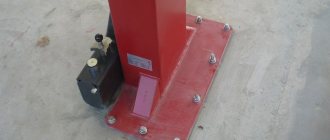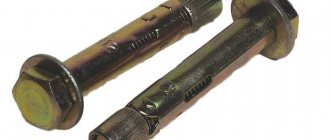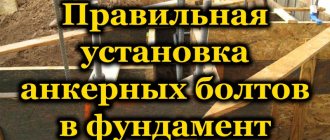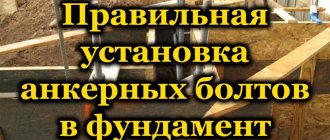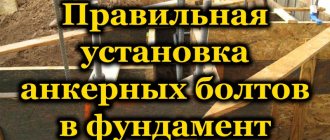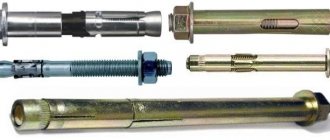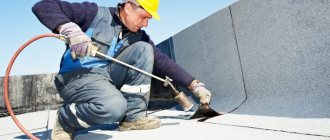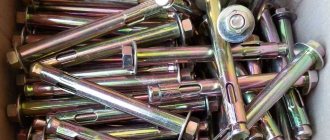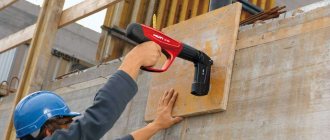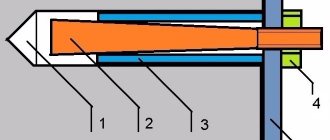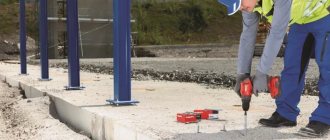On trading floors, fasteners are presented in a wide range. Let's look at a group of anchor bolts with their characteristics. Let us dwell on each type of “anchor” for a detailed study of the principle of operation and applicability. Let's get acquainted with the size range and what is hidden under the markings. After reading the article, you will understand what questions to ask the seller and what the master will expect from you.
Types of anchor bolt Source stroimaterials.ru
general characteristics
Anchors (anchor-type fasteners) are designed for permanent installation in solid, dense, porous and fragile foundations. They are used for hanging heavy equipment or furniture, fixing massive structures to the floor, walls and ceilings with a mineral composition (concrete, brick, foam blocks, etc.). In essence, this is a fastener that is a more durable and reliable alternative to nails with self-tapping screws.
The material for the manufacture of anchors can be adhesive mass, hard plastic or polyamide, metal alloy:
- Aluminum with zinc or brass for use in the domestic sector;
- Structural or carbon steel for increased loads and to ensure a safety margin for the connection;
- Corrosion-resistant or alloy steel with high moisture resistance is also able to withstand heavy loads.
The operating principle of various anchors is based on one of the physical phenomena:
- friction force;
- resistance to fracture and crushing;
- voltage compensation.
Concrete anchor with a ring Source cook.minemshop.ru
The consequences of incorrect installation of the fastener or exceeding the permissible load on the fastener can be of different nature:
- tearing out an anchor or a section of the base used for its immersion;
- violation of the shape, integrity of the bolt or body;
- destruction of fasteners due to corrosion or overheating (melting, burnout).
In order for the “anchor” to work according to the stated scheme, the fastening element must have an internal thread for screwing in the bolt. As a result of its advancement, the functional body expands in the middle or at the end. The chemical group of products works a little differently. Let's look at the types of anchors in more detail.
Types of anchors
Products are classified according to different criteria. So, the purpose can be universal, frame, ceiling or foundation, for a dense or porous base.
The shape can be straight or curved, the surface is smooth, grooved or threaded, and the structure is solid or prefabricated.
Installation involves hammering, screwing, gluing or through fastening. And on the basis of functional components, mechanical and chemical anchors are distinguished.
Frame “anchor” Source qurilish-mollari.uz
Mechanical
The group of mechanical anchors is represented by products that are installed using physical force and tools. Most of these products are made of metal. Plastic dowels are used less frequently.
Drivers
This type of anchor is used for installing utility lines. Externally, the fastener looks like a dowel, which is pushed into the prepared hole. It can be made of metal or polymers, and the seamless sleeve with a narrowed lower part (petals) inside has a thread and a wedging insert in the form of a shark tooth. The petals open when a bolt or stud is screwed in with a through passage.
The advantages of using such fasteners include the following:
- quick installation;
- shallow planting;
- continuous immersion;
- reliable fixation with vibration compensation;
- low cost.
But precision is required in forming the immersion hole. There is also a limitation - porous materials crumble when driving the sleeve. Therefore, installation is permissible only in a monolithic type structure with high strength values.
Drive-in anchor Source stpulscen.ru
The algorithm for installing a drive-in anchor for concrete is as follows:
- A hole is prepared corresponding to the external parameters of the sleeve;
- The body is immersed into the hole, followed by wedging using a center punch;
- The bolt is screwed in.
The hammer-in group includes ceiling anchors and dowel-nails. They are used for assembling suspended structures and installing mortgages. Such fasteners are also relevant for installing formwork, cable ducts, ventilation, and pipelines. Re-use of hardware is unacceptable, since the bushings cannot be dismantled. Therefore, bolts often act as anti-vandal or fireproof fasteners.
Wedge
This concrete anchor bolt is intended for the installation of heavy structures. In this case, the supporting base must be strong, without pores. No additional shirts are required.
The design of the hardware looks like this:
- threaded pin with tapered widened end;
- collet;
- screw.
Wedge fasteners Source freeimport.ru
The anchor is driven into a seat with the appropriate diameter. When the bolt is unscrewed, the wedge moves inside the collet clamp, the petals of which begin to move apart.
Spacers
According to the principle of operation, an expansion anchor for concrete is similar to a wedge anchor. Only instead of a collet clamp, the diameter of the lower part of the cylinder into which the pin is inserted increases in diameter. There may be 1-3 bushings. This is a disposable fastener that can withstand heavy loads. Immersion is carried out at great depths (compared to driven dowels). It is not recommended to use for porous substrates, but the density may be average.
By their nature, there are several 4 types of anchors:
- KA - electro-galvanized;
- KAK - hot-dip galvanized;
- KAN - acid resistant;
- RAR - stainless steel.
Spacer “anchor” Source ooonetbiz.ru
See also: Catalog of companies that specialize in storage systems and roof windows
The spacer part can be made in the form of a sleeve or bushing. The protruding part of the stud is designed in two ways: with a nut at the end or with a bracket (hook). The latter are relevant for the installation of suspended structures.
Mechanical anchor bolts - installation, types, applications
We have already discussed chemical anchors in this article, now I propose to consider mechanical anchor bolts.
Mechanical anchor bolt - operating principle, installation, types of bolts
Anchor bolts (photo 1) are designed for attaching suspended elements to the following bases:
- brick;
- concrete;
- stone;
- wood;
- natural stone, etc.
The anchor bolt consists of the following elements:
- internal bolt;
- screw;
- frame;
- plastic gasket.
Photo 1. Anchor bolts
Main advantages of mechanical anchors
- Withstands heavy loads.
- Easy and simple installation.
- Reduces installation time and reduces the complexity of the process.
- Quite durable mount.
Scope of application of mechanical anchors
Anchor bolts are used mainly in construction and repair work for fastening heavy structures, as they are able to withstand heavy loads. For example, using anchor bolts you can secure the following elements:
- water heater;
- sports wall;
- satellite dish;
- wall-mounted boiler;
- wall furniture, etc.
Thus, the main purpose of anchor bolts is:
- fastening heavy elements;
- connection between different elements.
The principle of operation of an anchor bolt . The anchor bolt should be installed in a pre-prepared hole of the required diameter. Then tighten the nut using a wrench. The nut, moving towards the base of the bolt, wedges the body of the anchor bolt, which leads to fixation of the anchor in the hole. The anchor bolt is fixed in the hole using friction and thrust forces.
Sequence for installing a mechanical anchor bolt
- Determining the position of the anchor; marking.
- Drilling a hole using a hammer drill. The diameter of the hole must match the outer diameter of the anchor bolt. The length of the hole must be no less than the length of the anchor.
- Cleaning the hole from dust.
- Installing the anchor into the hole. The anchor should go in tightly, preferably with a light tap with a hammer.
- Fixing the anchor bolt in the wall by tightening the nut in a clockwise direction.
Photo 2. Sequence of work for installing an anchor bolt
Main dimensions of mechanical anchor bolts
All anchor bolts have their own markings, photo 3. For example:
- 8x6x60 or 8/6x60;
- 12x10x100 or 12/10x100;
- 16x12x110 or 16/12x110.
Below is a simple explanation of the markings of anchor bolts:
- the first digit is the outer diameter of the anchor, mm;
- the second number is the diameter of the internal bolt, mm;
- the third number is the total length of the anchor, mm.
Anchor bolts may have the following letter designations:
- HA – ring anchor;
- HG – anchor with hook;
- HL – anchor with a 90° bend.
Photo 3. Dimensions and markings of anchor bolts
The main types of anchor bolts are shown in photo 4 and in table. 1.
Photo 4. Types of anchor bolts: a) wedge; b) screw; c) folding spring anchor with a pin; d) frame anchor; e) anchor with undercut; f) driven anchor wedge; g) anchor sleeve; h) anchor hook or anchor with a ring; j) anchor with a replaceable spring; l) spacer; m) embedded anchor
Types of Mechanical Anchor Bolts
Table 1
| Type of anchor bolt | Mounting features, advantages, disadvantages | Application area |
| 1. Wedge anchor (stud anchor) | Feature: universal fastener. Operating principle: an anchor is inserted (hammered) into a pre-drilled hole; after tightening the nut on the anchor, the spacer ring on the back wall is released. | For external work in industrial construction. |
| 2. Screw anchors | Feature: its design is the same as a wedge anchor, but instead of a nut and bolt, a screw is installed. | Same |
| 3. Collapsible spring anchor with stud | Operating principle: the anchor is inserted into the hole and the nut is tightened, the petals unfold and fix the secure position of the anchor. | For attaching various hanging elements. For installation of load-bearing consoles, heavy structures, cables, masts, fences to solid bases and partitions. |
| 4. Frame anchor | Operating principle: as a result of tightening the screw, the bushing becomes wedged. The connection is wedged using a brass or steel collet. Feature: This is a lightweight version of the anchor bolt. The frame anchor has a head shape that allows it to be screwed to the same level as the base surface. | For attaching various hanging elements. For fastening plastic and wooden structures of window frames, as well as slotted bricks, concrete, stone. |
| 5. Undercut anchor | The principle of operation is the same as that of a wedge anchor bolt | For fastening in hard bases: concrete, stone. |
| 6. Driven anchor wedge | Feature: Similar in design to a hairpin with a locking cap and a wedge that moves along the hairpin. Installation is done manually or using a pneumatic tool. Operating principle: the wedge anchor is fixed by driving the wedge into the pin (notched metal sleeve). | For fastening in dense substrates. |
| 7. Anchor sleeve ( bolt with sleeve) | Operating principle: when the bolt is tightened, the sleeve expands. | For fastening to rigid solid bases. |
| 8. Hook anchor or ring anchor | Feature: instead of a straight bolt, a hook is installed in the anchor - bent at 90°. Operating principle: frame and wedge clamp. | For creating guy ropes, suspensions, tensioning cables, putting on chains. For fastening to thin concrete partitions |
| 9. Anchor with replaceable spring | Operating principle: installation is carried out using a wrench, the spring is a wedging device. Can be with a hook or a ring. | For installation of temporary or thin-walled structures. For use in interior design. |
| 10. Expansion anchor | Operating principle: the head of the bolt is inserted into the hole, and then the bolt is screwed in, as a result of which the spacer ring located on the back part is unclenched. A type of expansion anchor is a double expansion anchor, which has two sleeves, which allows for a more reliable connection. | Fastening to rigid bases. For fastening a massive structure to a base made of concrete, brick or stone. |
| 11. Mortgage anchor | Operating principle: installed in concrete at the construction stage, after the concrete has gained strength, the anchor can be used. | The anchor is designed for high loads. |
General characteristics of mechanical anchor bolts
- Anchor bolts are made of high-strength alloy steel of the following grades (6...8 strength category):
- 09G2S6;
- 10G2S1-6.
- Possible diameter of the anchor rod is 6...20 mm.
- The standard length of the rods is 45…220 mm.
- Weight – 16...100 g.
- The pulling force in concrete is 10.5...18.3 kN.
- The permissible bending moment is 5.2…25.7 N´m.
- Maximum torque – 10…40 N´m.
High-quality anchor bolts are coated with a protective anti-corrosion layer of zinc 40...45 microns thick.
Depending on the intended use, anchor bolts are divided into:
- constructive or standard;
- calculated – for specific and responsible tasks.
The author of the publication is an expert from GIDproekt
Konev Alexander Anatolievich
Video description
From the video you can find out how the anchor behaves in a load-bearing foundation:
Expanding
This concrete anchor is a petal sleeve with a built-in nut at the end. As a result of screwing in the bolt, the entire body expands, except for the edges. This explains the applicability of the products for working with porous and hollow substrates.
Such fasteners can be dismantled and reused if desired. For through immersion of the pin, the hole for the “anchor” is drilled to a depth with a margin of 20 mm. For the calculation, the length of the sleeve is taken.
Expansion fastener Source www.obudom.com
Frame
These anchors are designed for mounting window frames and door frames. The operating principle of the “anchor” is based on expansion-type hardware. Only the petals are shifted to the lower part of the body. And on the top there are molded stops that prevent rotation and displacement of the sleeve.
Chemical
Such anchors are represented by bolts or studs, which are immersed in a liquid, quickly hardening mass with adhesive properties. As a result, the load on the hardware is distributed evenly along the entire length. This makes it possible to install fasteners in any base: dense, porous, fibrous or hollow.
The working mass of a chemical anchor is a two-component resin of synthetic origin (the second substance is intended to accelerate the hardening of the composition). The advantages of fasteners include the following:
- high connection strength;
- the possibility of eliminating toxic substances from the composition;
- no odor;
- dry residue hardness without thermal expansion;
- applicability for almost any substrate outdoors and indoors;
- hermetic filling of voids in the seat;
- maintaining technical characteristics for more than 50 years.
Dowel made of hardened resin Source kayrosblog.ru
Installation rules
Installation begins with drilling the base with a drill corresponding to the anchor so that it fits into the hole with some effort, from which the remains of construction debris are first removed. Next, the anchor is driven into the hole with a hammer. The nut on the bolt is then tightened as much as possible to ensure maximum wedging of the anchor into the base.
At the end of the process, you need to give the nut back and screw it onto the stud, and tighten the nut again. When using anchors with a chemical operating principle, drill a hole in the base, hammer in the anchor, and then insert a pin into it. The ampoule in the anchor breaks, and the compound in it tightly glues the pin.
Lanyard for rigging workCrab system for profile pipes: features of the selection and use of fastening systems and connecting elements
What is a rigging shackle? Size standards, modern types, rules and features of choice
Marking
In order to decide on the choice of certain anchors for concrete, sizes, you can consider the product labeling. The permissible load is indicated in product certificates, and on price tags - physical parameters that must be observed when using fasteners. The decoding using the example of the M8 10/35*90 product looks like this:
- M8 - diameter of the thread applied to the shaft of a bolt or stud;
- 10 - diameter of the seat and drill for drilling it out;
- 35 - permissible thickness of the structure being fixed;
- 90 is the minimum size of the hole recess for the anchor clamp.
Drill for concrete Source www.texnik52.ru
The dimensions of anchor bolts for concrete vary depending on the purpose. So, for domestic needs it is enough to limit yourself to a diameter of 12 mm and a length of 20 cm. For heavy structures, the parameters are increased to 20 mm and 35 cm, respectively. This suggests that the thickness for fixed structures can be 1.5-6 cm, and for a load-bearing base - 5-30 cm.
Briefly about the main thing
The concrete anchor bolt is designed for fixing heavy structures and equipment.
Mechanical anchors vary in structure. They can be driven, spacer, wedge, sliding and frame. They are used to work with dense or porous substrates.
Chemical anchors are available as ampoule or injection. The first ones have a glass dowel and a small amount of liquid mass. Suitable for monolithic concrete. The latter are relevant for any base, since the resinous adhesive substance fills almost the entire space of the seat until it begins to harden.
The marking will allow you to decide on the choice of anchors based on size, and the accompanying documentation based on load-bearing capacity.
Important parameters and types of anchor bolts
Bolts are made according to GOST from high-strength alloy steels. In general, an anchor bolt is a cylindrical steel rod 45-225 mm long. One end is equipped with a thread, the other is fastening. Any anchor looks like a sleeve with a spacer element made in the form of a conical nut.
When the fastener is screwed into the supporting structure for the anchor, the coupling is greatly deformed under its influence, creating a strong adhesion to the base. Due to this, it is possible to pull the bolt out of the wall with only part of it.
The classification of anchor bolts, in addition to their size and material of manufacture, is made according to the following parameters:
- method of coupling at the base - drilling, driving, screw;
- type of fixation at the attachment point - extension, tube, spacer;
- structural nuances of the anchor - solid, rod, prefabricated, cylindrical.
In addition to the above classification, anchor bolts, according to their design features, can be either temporary or permanent.
Such good adhesion is achieved in the presence of a stop and a sufficient effective friction force. Chemical type anchor bolts are also held in place by the resin that glues the bolt to the anchor.
There is such a technical characteristic as the pull-out indicator of an anchor bolt, which shows how much force must be applied to pull the bolt out of the anchor. The applied force is measured in kilonewtons, and according to GOST it must exceed 10.5 kN.
Breakout of an anchor bolt, as a rule, occurs in two cases: if the bolt was screwed in at an insufficient number of turns, or when the conical nut was pulled out. Another option is to tear it out together with a dowel and a fragment of the wall.
Bending and torsional strength are also important. For the bending moment of the anchor bolt, this value should not exceed 5-25 nm, for the torsional moment - 10-40 nm. The lower these indicators, the stronger and stiffer the bolt.
